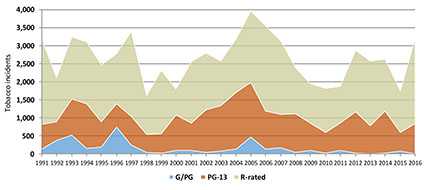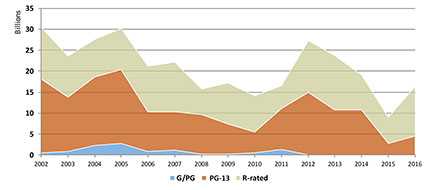Smoking in the Movies
Background
- The Surgeon General’s Report concluded that exposure to onscreen smoking in movies causes young people to start smoking.1
- There are 5.6 million youth alive today who are projected to die from tobacco related diseases if current trends continue.2
- Giving an R rating to future movies with smoking would be expected to reduce the number of teen smokers by nearly 1 in 5 (18%),2,3 preventing up to 1 million deaths from smoking among children alive today.2
Movie Ratings4
G (General Audience): All ages admitted
PG (Parental Guidance Suggested): Some material may not be suitable for children
PG-13 (Parents Strongly Cautioned): Some material may be inappropriate for children under 13
R (Restricted): Under 17 requires accompanying parent or adult guardian
NC-17 (Adults Only): No one 17 and under admitted
- From 2002 to 2016:
- Almost half (46%) of top-grossing movies in the United States were rated PG-13.
- 6 of every 10 PG-13 movies (58%) showed smoking or other tobacco use.
- The percentage of youth-rated movies (G, PG, PG-13) that were smokefree increased from 35% to 74%; however, in youth-rated movies that showed any smoking, the average number of tobacco incidents per movie climbed to historically high levels in 2014 [n=38] and were nearly as high [n=34] in 2016.5
- The Motion Picture Association of America (MPAA), the studios’ organization that assigns ratings, provides a “smoking label” along with the regular rating for some movies that contain smoking. However, almost 9 of every 10 (89%) youth-rated, top-grossing movies with smoking do not carry an MPAA “smoking label.”5
- All six major movie companies that belong to MPAA have published individual policies addressing tobacco depictions in their movies.5
- Disney (2004)
- Time Warner’s Warner Bros. (2005)
- Comcast’s Universal (2007)
- Fox and Sony (2012)
- Viacom’s Paramount (2013)

Text description of this infographic is available on a separate page.
Notes:
- A “tobacco incident” is one occurrence of smoking or other tobacco use in a movie.
- “Incidents” are a measure of the number of occurrences of smoking or other tobacco use in a movie.
- A “tobacco impression” is one person seeing one incident.
- “Impressions” are a measure of total audience exposure.
- This report’s movie sample comprises all movies that ranked among the top 10 in ticket sales (“top-grossing movies”) in any week of their first-run release to U.S. theaters.
Additional 2016 Findings5
- The percentage of PG-13 movies with tobacco incidents declined from 47% in 2015 to 35% in 2016.
- About half of PG-13 movies (53%) were tobacco-free in 2015—a level substantially unchanged since 2010 (57% tobacco-free).
- In 2016, the number of tobacco incidents in the average youth-rated movie with tobacco (34 incidents) was 70% higher than in 2015 (20 incidents). The number in the average R-rated movie with tobacco (67 incidents) was higher than in any year since at least 2002 and more than double the level of 2015 (30 incidents).
- All but one movie rated G or PG was tobacco-free in 2016. The total number of tobacco incidents in movies rated PG dropped to an historic low from 2015 to 2016 (from 88 to 4).
- PG-13 movies included more tobacco incidents in 2016 (809) than they did in 2015 (519). The total number of incidents in youth-rated movies in 2016 (813) was approximately two-thirds the number in 2002 (1,296).
- A significant downward trend occurred in the number of tobacco incidents in youth-rated films between 2005 and 2010, but incidents were essentially flat from 2010 through 2016. Had the average rate of decline in tobacco incidents per year observed between 2005 and 2010 been maintained, tobacco incidents would have been eliminated from all youth-rated films by early 2015.
Figure 1. Tobacco Incidents in Top-Grossing Movies by Motion Picture Association of America (MPAA) Rating, 1991–20165
 Text description of this graph is available on a separate page.
Text description of this graph is available on a separate page.
- The number of tobacco incidents in movies varies by movie company. From 2010 to 2016:6
- Tobacco incidents increased in youth-rated movies from
- Time Warner
- Comcast
- Fox
- Sony
- Viacom Paramount
- Tobacco incidents decreased in movies from independent movie companies and Disney.
- Tobacco incidents increased in youth-rated movies from
Figure 2. In-Theater Tobacco Impressions by Motion Picture Association of America (MPAA) Rating, 2002–20165
 Text description of this graph is available on a separate page.
Text description of this graph is available on a separate page.
Conclusions
- Data show that individual movie company policies alone have not been efficient at minimizing smoking in movies. Movie companies with tobacco depiction policies included tobacco in as many of their youth-rated movies in 2016 as they did in 2010 [18 in 2010; 17 in 2016] and each of these movies included more tobacco incidents, on average [25 incidents per movie in 2010; 40 incidents per movie in 2016].5
- The increase of tobacco incidents in PG-13 movies since 2010 is of particular public health concern because of the established causal relationship between youth exposure to smoking in movies and smoking initiation.6
- Reducing tobacco incidents that appear in youth-related movies would prevent the initiation of tobacco use among young people.1-3,5-7
- Opportunities exist for movie studios to reduce tobacco incidents that appear in youth-rated movies, including rating films with smoking as R.6,7
- Other available interventions include certifying that no payments have been received by the producers and distributors for depicting tobacco use; and ending the onscreen depiction of actual tobacco brands.6,7
- State and local health departments could also work with state agencies that manage movie subsidies to ensure that such subsidies do not go to films that include depictions of tobacco use.6
References
- U.S. Department of Health and Human Services. Preventing Tobacco Use Among Youth and Young Adults: A Report of the Surgeon General. Atlanta, U.S. Department of Health and Human Services, Centers for Disease Control and Prevention and Health Promotion, Office on Smoking and Health, 2012 [accessed 2017 July 6].
- U.S. Department of Health and Human Services.. The Health Consequences of Smoking—50 Years of Progress: A Report of the Surgeon General. Atlanta: U.S. Department of Health and Human Services, Centers for Disease Control and Prevention, National Center for Chronic Disease Prevention and Health Promotion, Office on Smoking and Health, 2014 [accessed 2017 July 6].
- Sargent JD, Tanski S, Stoolmiller M. Influence of Motion Picture Rating on Adolescent Response to Movie Smoking. Pediatrics 2012: 130:1-9 [accessed 2017 July 6].
- Motion Picture Association of America. Film Ratings [accessed 2017 July 6].
- Polansky J, Titus K, Atayeva R, Glantz S. Smoking in Top-Grossing U.S. Movies, 2016 University of California, San Francisco, Center for Tobacco Control Research and Education, 2016 [accessed 2017 July 6].
- Centers for Disease Control and Prevention. Tobacco Use in Top-Grossing Movies — United States 2010-2016. Morbidity and Mortality Weekly Report. [accessed 2017 July 6].
- World Health Organization. Smoke-Free Movies: From Evidence to Action[PDF–754 KB]. Geneva, Switzerland, World Health Organization; 2009. [accessed 2017 July 6].
For Further Information
Centers for Disease Control and Prevention
National Center for Chronic Disease Prevention and Health Promotion
Office on Smoking and Health
E-mail: tobaccoinfo@cdc.gov
Phone: 1-800-CDC-INFO
Media Inquiries: Contact CDC’s Office on Smoking and Health press line at 770-488-5493.
- Page last reviewed: July 5, 2017
- Page last updated: July 5, 2017
- Content source:


 ShareCompartir
ShareCompartir